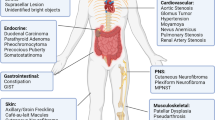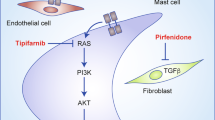Abstract
Human clinical neurofibromatosis type 1 (NF1) and type 2 (NF2) result from mutations and inactivation of neurofibromin and merlin genes, respectively, which negatively regulate Ras pathways. To evaluate the contribution of N-Ras activity to the development of NF, we generated a novel transgenic mouse expressing oncogenic N-ras specifically in central nerve cells, neural crest-derived cells and lens epithelial cells. Soon after birth, the mouse skin showed hyperpigmentation of the epidermis and melanin-laden macrophages in the dermis, as observed in the café-au-lait spots of human cases. At 3 months of age, all the mice had neurofibromas in the skin and neurofibroma-like tumors with structure similar to Wagner–Meissner bodies in the adrenal medulla. At 4 months of age, all the mice developed subcapsular cataract. In the 5th month, some developed protruding dermal neurofibromas involving subcutaneous fat. However, plexiform neurofibroma, schwannoma, astrocytoma and pheochromocytoma were not observed in the mice, suggesting a requirement for signal(s) other than the activated N-Ras pathway to induce these tumors. Thus, the activated N-Ras signal may be a main pathway for the development of the disease phenotypes characteristic of NF.
This is a preview of subscription content, access via your institution
Access options
Subscribe to this journal
Receive 50 print issues and online access
$259.00 per year
only $5.18 per issue
Buy this article
- Purchase on Springer Link
- Instant access to full article PDF
Prices may be subject to local taxes which are calculated during checkout




Similar content being viewed by others
References
Bajenaru ML, Zhu Y, Hedrick NM, Donahoe J, Parada LF, Gutmann DH . (2002). Astrocyte-specific inactivation of the neurofibromatosis 1 gene (NF1) is insufficient for astrocytoma formation. Mol Cell Biol 22: 5100–5113.
Basu TN, Gutmann DH, Fletcher JA, Glover TW, Collins FS, Downward J . (1992). Aberrant regulation of ras proteins in malignant tumour cells from type 1 neurofibromatosis patients. Nature 356: 713–715.
Buchberg AM, Cleveland LS, Jenkins NA, Copeland NG . (1990). Sequence homology shared by neurofibromatosis type-1 gene and IRA-1 and IRA-2 negative regulators of the RAS cyclic AMP pathway. Nature 347: 291–294.
Chadee DN, Xu D, Hung G, Andalibi A, Lim DJ, Luo Z et al. (2006). Mixed-lineage kinase 3 regulates B-Raf through maintenance of the B-Raf/Raf-1 complex and inhibition by the NF2 tumor suppressor protein. Proc Natl Acad Sci USA 103: 4463–4468.
Enzinger FM, Weiss SW . (1988). Soft Tissue Tumor, 2nd edn. The C.V. Mosby Company: Washington, pp 852–863.
Evans DG, Sainio M, Baser ME . (2000). Neurofibromatosis type 2. J Med Genet 37: 897–904.
Giovannini M, Robanus-Maandag E, van der Valk M, Niwa-Kawakita M, Abramowski V, Goutebroze L et al. (2000). Conditional biallelic Nf2 mutation in the mouse promotes manifestations of human neurofibromatosis type 2. Genes Dev 14: 1617–1630.
Hogan B, Constantin F, Lacy E . (1994). Manipulating the Mouse Embryo: A Laboratory Manual, 2nd edn. Cold Spring Harbor Press: New York.
Ikeda K, Saeki Y, Gonzalez-Agosti C, Ramesh V, Chiocca EA . (1999). Inhibition of NF2-negative and NF2-positive primary human meningioma cell proliferation by overexpression of merlin due to vector-mediated gene transfer. J Neurosurg 91: 85–92.
Kunisada T, Yamazaki H, Hirobe T, Kamei S, Omoteno M, Tagaya H et al. (2000). Keratinocyte expression of transgenic hepatocyte growth factor affects melanocyte development, leading to dermal melanocytosis. Mech Dev 94: 67–78.
Lakkis MM, Golden JA, O'Shea S, Epstein JA . (1999). Neurofibromin deficiency in mice causes exencephaly and is a modifier for Splotch neural tube defects. Dev Biol 212: 80–92.
Lim JY, Kim H, Kim YH, Kim SW, Huh PW, Lee KH et al. (2003). Merlin suppresses the SRE-dependent transcription by inhibiting the activation of Ras-ERK pathway. Biochem Biophys Res Commun 302: 238–245.
Malumbres M, Pellicer A . (1998). RAS pathways to cell cycle control and cell transformation. Front Biosci 3: d887–d912.
Mattingly RR, Kraniak JM, Dilworth JT, Mathieu P, Bealmear B, Nowak JE et al. (2006). The mitogen-activated protein kinase/extracellular signal-regulated kinase kinase inhibitor PD184352 (CI-1040) selectively induces apoptosis in malignant schwannoma cell lines. J Pharmacol Exp Ther 316: 456–465.
McClatchey AI, Saotome I, Ramesh V, Gusella JF, Jacks T . (1997). The Nf2 tumor suppressor gene product is essential for extraembryonic development immediately prior to gastrulation. Genes Dev 11: 1253–1265.
Morrison H, Sherman LS, Legg J, Banine F, Isacke C, Haipek CA et al. (2001). The NF2 tumor suppressor gene product, merlin, mediates contact inhibition of growth through interactions with CD44. Genes Dev 15: 968–980.
North K . (2000). Neurofibromatosis type 1. Am J Med Genet 97: 119–127.
Patton EE, Widlund HR, Kutok JL, Kopani KR, Amatruda JF, Murphey RD et al. (2005). BRAF mutations are sufficient to promote nevi formation and cooperate with p53 in the genesis of melanoma. Curr Biol 15: 249–254.
Reed N, Gutmann DH . (2001). Tumorigenesis in neurofibromatosis: new insights and potential therapies. Trends Mol Med 7: 157–162.
Saito H, Tsumura H, Otake S, Nishida A, Furukawa T, Suzuki N . (2005). L7/Pcp-2-specific expression of Cre recombinase using knock-in approach. Biochem Biophys Res Commun 331: 1216–1221.
Sato N, Funayama N, Nagafuchi A, Yoneyama S, Tsukita S, Tsukita S . (1992). A gene family consisting of ezrin, radixin and moesin. Its specific localization at actin filament/plasma membrane association sites. J Cell Sci 103: 131–143.
Tikoo A, Varga M, Ramesh V, Gusella J, Maruta H . (1994). The minimal fragments of c-Raf-1 and NF1 that can suppress v-Ha-Ras-induced malignant phenotype. J Biol Chem 269: 23387–23390.
Tsukamoto K, Jackson IJ, Urabe K, Montague PM, Hearing VJ . (1992). A second tyrosinase-related protein, TRP-2, is a melanogenic enzyme termed DOPAchrome tautomerase. EMBO J 11: 519–526.
Tsumura H, Yoshida T, Saito H, Imanaka-Yoshida K, Suzuki N . (2006). Cooperation of oncogenic K-ras and p53 deficiency in pleomorphic rhabdomyosarcoma development in adult mice. Oncogene 25: 7673–7679.
Voice JK, Klemke RL, Le A, Jackson JH . (1999). Four human ras homologs differ in their abilities to activate Raf-1, induce transformation, and stimulate cell motility. J Biol Chem 274: 17164–17170.
Zhu Y, Ghosh P, Chammay P, Bums DK, Parada LF . (2002). Neurofibromas in NF1: Schwann cell origin and role of tumor environment. Science 296: 920–922.
Acknowledgements
We thank Dr Hearing for TRP2 antibodies, Dr Kunisada for a helpful suggestion in histology and Mr Otake for his excellent assistance in animal generation and maintenance.
Author information
Authors and Affiliations
Corresponding author
Rights and permissions
About this article
Cite this article
Saito, H., Yoshida, T., Yamazaki, H. et al. Conditional N-rasG12V expression promotes manifestations of neurofibromatosis in a mouse model. Oncogene 26, 4714–4719 (2007). https://doi.org/10.1038/sj.onc.1210250
Received:
Revised:
Accepted:
Published:
Issue Date:
DOI: https://doi.org/10.1038/sj.onc.1210250
Keywords
This article is cited by
-
Tumorigenesis in neurofibromatosis type 1: role of the microenvironment
Oncogene (2021)
-
Cutaneous neurofibromas in the genomics era: current understanding and open questions
British Journal of Cancer (2018)



